
Our kitesurf instructors guarantee a smooth, safe introduction to the sport with courses that will turn anyone into a confident kitesurfer. Lessons are taught in a series of progressive steps, always moving onto the next stage once the current teaching points have been mastered.
Beginners start out with an introduction to the theory and practice of kite-flying by using a small trainer kite on dry land. Once this has been mastered and confidence built, you then move onto a bigger inflatable kite for some fun rounds of body-dragging through the water. This is done without the use of a board on your feet, allowing you to concentrate on getting used to the pull of the kite and the techniques of steering and controlling it. At the end this stage, you will be able to control the kite and cope with its tremendous traction in every situation, and to manage a safe launch and landing.
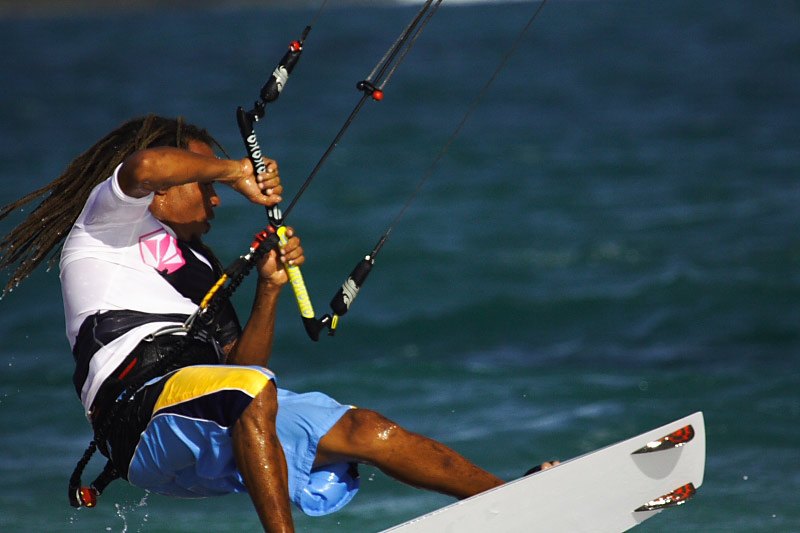
Further practice then takes place in the water and you learn how to relaunch the kite from the water after a fall and make your first attempts at standing upright on the board. This is the introduction to the waterstart, which involves getting up and standing on the board while being pulled along by the kite. At this stage, the basic skills for successful kitesurfing have been learned. Once you have successfully completed the beginners course, you can learn how to surf upwind in the advanced course.
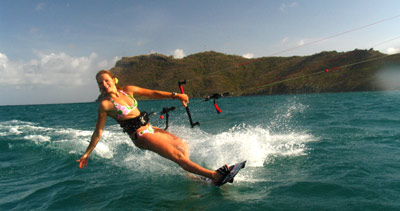
We also offer courses for advanced kitesurfers, where manoeuvres and techniques can be enhanced … it’s your chance to get in those first jumps. Naturally a rescue boat is at hand during instruction.
Please note that all courses depend on there being suitable wind conditions. You will be taught using high-quality Cabrinha kites and use of all equipment is included in the cost.
You will be taught using high-quality Cabrinha kites and use of all equipment is included in the cost.
The Teaching System
LEVEL 1 – Discovery Kiteboarder Program:
| Level A-1 |
- Carry and set up the lines and kite
- Determine the wind direction and upwind and downwind (windward, leeward).
- Fly a small kite (inflatable, stunt kite, foil.) on the wind window edge and maintain it close to the ground.
- Know how to stop the kite power in case of problem by releasing the bar. Be aware that the kite leash must be worn at all times, before kite launching and until landing
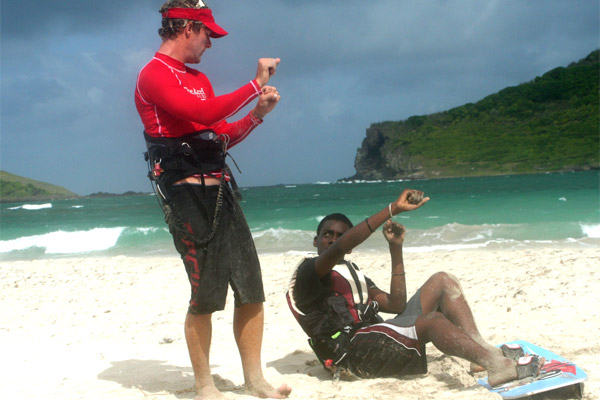
|
| Level B-1 |
- Be aware of the area where the kite can fall downwind to the pilot.
- Recover the kite on land.
- Position the kite on request from 9 to 3 o’clock on the wind window edge.
- Launch a kite with an assistant and choose the right angle to the wind.
- Fly the kite in the power area without crashing it.
- Twist and untwist the lines while the kite flies.
- Recover a kite and secure it on land.
- Land a kite with the help of an assistant.
|
| Level C-1 |
- Fly a kite hooked to the harness.
- Pilot hooked to the harness with one hand.
- Activate the harness release system or quick release located on a leader line.
|
| Level D-1 |
- Perform a downwind course by body dragging and using the power of the kite.
|
Level
E-1 |
- Relaunch a kite from the water.
- Wind the lines in the water and recover the kite.
- Perform a self-rescue in deep water.
- Launch a kite alone on land.
- Identify potential wind obstacles creating lift or down draft and be able to define the wind direction. Understand that practice with onshore wind is dangerous.
|
|
LEVEL 2 – Intermediate Kiteboarder Program:
| Level F-2 |
- Define if the practice area is safe for practice.
- Set up and check the equipment alone (kite, line, control bar).
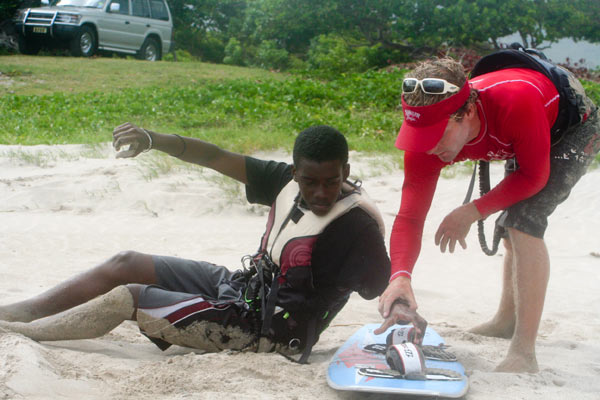
|
| Level G-2 |
- Go away from the shore (with side-shore and side-on-shore wind) while body dragging, go down wind and come back to the shore.
- In the water, pilot a kite with power from one side of the wind window to the other, passing by the power area. The pilot must be able to perform while piloting the kite at different heights from the water.
- Perform the previously mentioned exercise while piloting with one hand.
|
| Level H-2 |
- Know the water start theory: board and body positioning, kite piloting.
- Recover the board in deep water and position the feet in the foot-straps and keep the position while flying the kite.
|
| Level I-2 |
- Stand up on the board and ride while moving the kite up and down.
- Set up a 4-line kite alone and check that it is properly done. Obligatory at this point if it hasn’t been done before.
- Fly 4-line kite.
- Activate the safety systems of a 4-line bar (power loop, leash).
- Adjust a four line kite while using the power loop.
- Adjust the trim system of a 4-line kite to prevent it from flying backwards or to adjust the power.
|
LEVEL 3 – Independent Kiteboarder Program:
| Level J-3 |
- Know the right of way rules.
- Ride away from the shore and return to the shore.
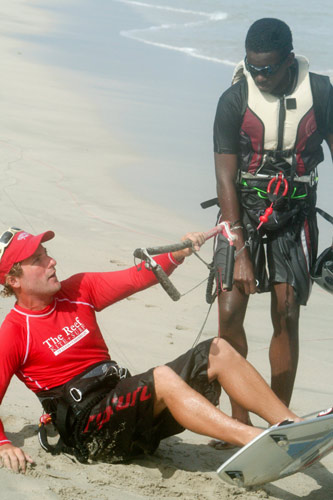
|
| Level K-3 |
- Edge on the heel and toe side to change course.
- Accelerate by edging down and moving the kite.
- Stop by edging.
- Be able to keep an edge.
|
| Level L-3 |
- Ride away from the shore and come back at starting point. Ride upwind.
- Constantly ride upwind.
|
| Level M-3 |
- Recover the board by body dragging upwind.
- Change direction.
|
| Level N-3 |
- Know the theoretical approach to jumps.
- Perform a small jump and land.
|
 You will be taught using high-quality Cabrinha kites and use of all equipment is included in the cost.
You will be taught using high-quality Cabrinha kites and use of all equipment is included in the cost.





